The AMD Radeon R9 290 Review
by Ryan Smith on November 5, 2013 12:01 AM EST- Posted in
- GPUs
- AMD
- Radeon
- Hawaii
- Radeon 200
Compute
Jumping into pure compute performance, this is another scenario where the 290X shouldn’t throttle as much, and as such the performance differences between the 290 and 290X should be closer to what they are on paper. With compute workloads the ROPs aren’t being hit hard, so that’s power and thermal savings that lets both cards operate at close to their maximum boost clocks.
As always we'll start with our DirectCompute game example, Civilization V, which uses DirectCompute to decompress textures on the fly. Civ V includes a sub-benchmark that exclusively tests the speed of their texture decompression algorithm by repeatedly decompressing the textures required for one of the game’s leader scenes. While DirectCompute is used in many games, this is one of the only games with a benchmark that can isolate the use of DirectCompute and its resulting performance.
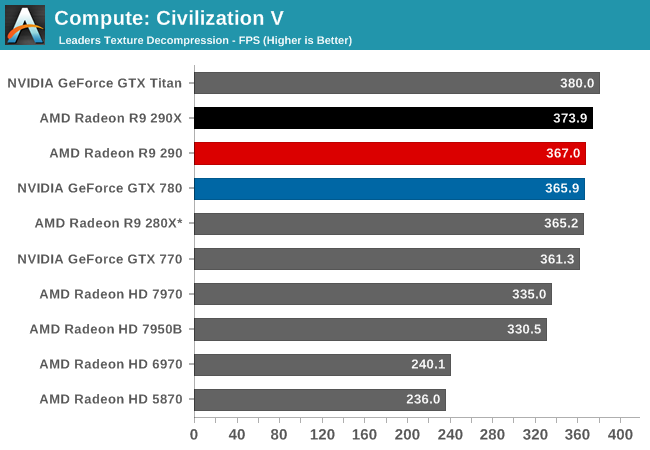
As with the 290X, Civ V can’t tell us much of value due to the fact that we’re running into CPU bottlenecks, not to mention increasingly absurd frame rates. The 290 is marginally slower than the 290X due to the lower clockspeeds and missing CUs, but minimally so.
Our next benchmark is LuxMark2.0, the official benchmark of SmallLuxGPU 2.0. SmallLuxGPU is an OpenCL accelerated ray tracer that is part of the larger LuxRender suite. Ray tracing has become a stronghold for GPUs in recent years as ray tracing maps well to GPU pipelines, allowing artists to render scenes much more quickly than with CPUs alone.
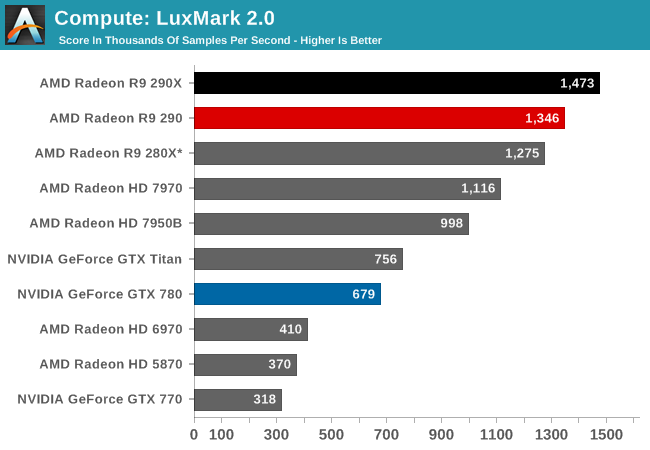
With both cards unthrottled and bound solely by shader performance, it’s an outright foot race for the Radeon cards. 290 trails 290X by around 9%, closely mirroring the difference in the CU count between the two cards. Though 290 is being very closely chased by the 280X, as Hawaii in general seems to have trouble getting the most out of its shader hardware on this benchmark.
Our 3rd compute benchmark is Sony Vegas Pro 12, an OpenGL and OpenCL video editing and authoring package. Vegas can use GPUs in a few different ways, the primary uses being to accelerate the video effects and compositing process itself, and in the video encoding step. With video encoding being increasingly offloaded to dedicated DSPs these days we’re focusing on the editing and compositing process, rendering to a low CPU overhead format (XDCAM EX). This specific test comes from Sony, and measures how long it takes to render a video.
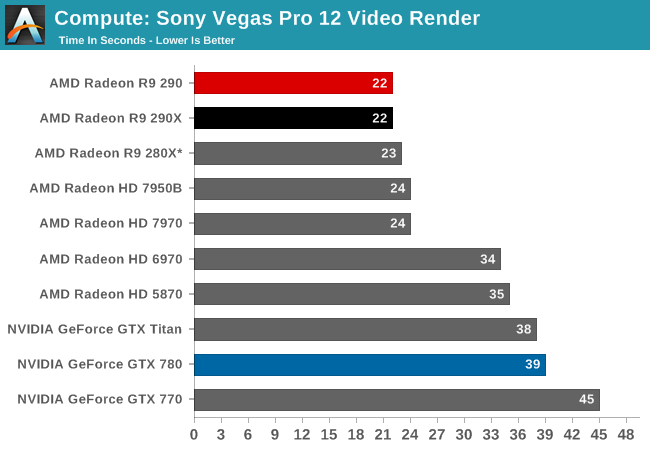
There’s not enough of a GPU performance difference between the two cards to matter with this test. Both tie at 22 seconds.
Our 4th benchmark set comes from CLBenchmark 1.1. CLBenchmark contains a number of subtests; we’re focusing on the most practical of them, the computer vision test and the fluid simulation test. The former being a useful proxy for computer imaging tasks where systems are required to parse images and identify features (e.g. humans), while fluid simulations are common in professional graphics work and games alike.
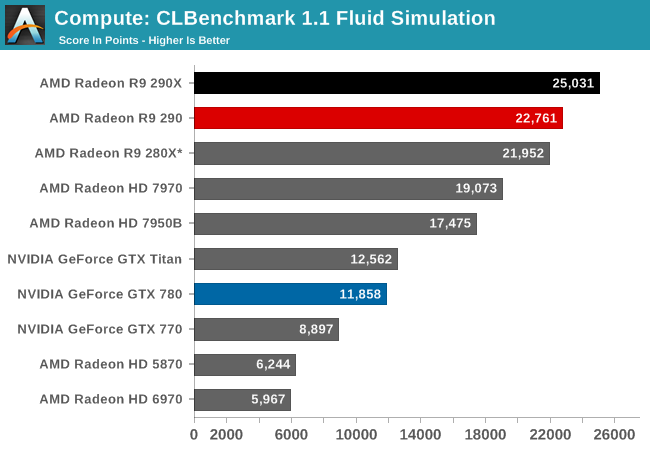

In the CLBenchmark fluid simulation the 290X and 290 take the top spots as expected, with the 290 trailing once more by 9%. However both Hawaii cards are still struggling with the computer vision benchmark, leading to the 290 being edged out by the 7970 of all things.
Moving on, our 5th compute benchmark is FAHBench, the official Folding @ Home benchmark. Folding @ Home is the popular Stanford-backed research and distributed computing initiative that has work distributed to millions of volunteer computers over the internet, each of which is responsible for a tiny slice of a protein folding simulation. FAHBench can test both single precision and double precision floating point performance, with single precision being the most useful metric for most consumer cards due to their low double precision performance. Each precision has two modes, explicit and implicit, the difference being whether water atoms are included in the simulation, which adds quite a bit of work and overhead. This is another OpenCL test, as Folding @ Home has moved exclusively to OpenCL this year with FAHCore 17.
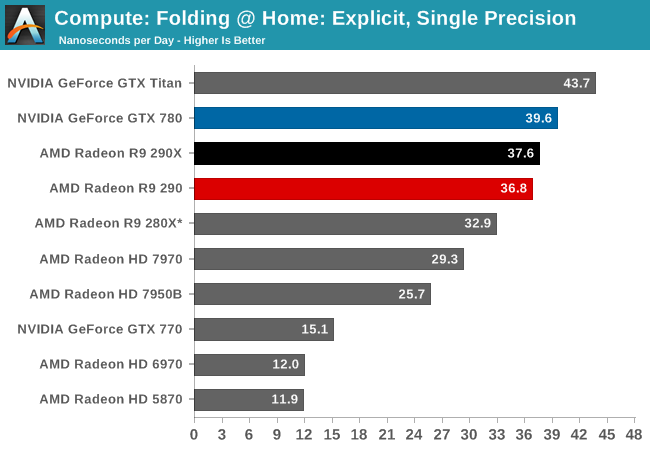
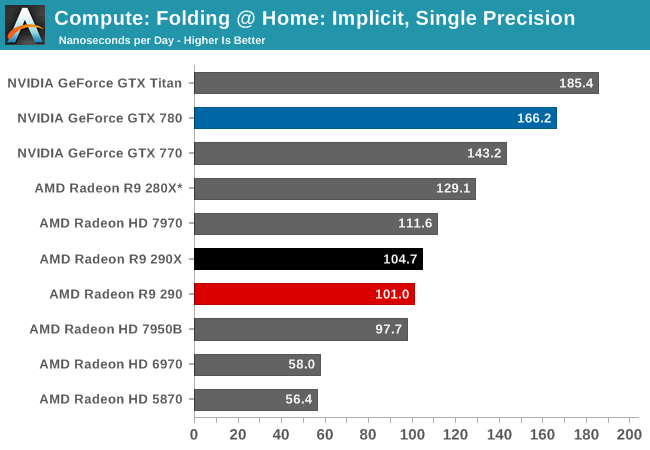
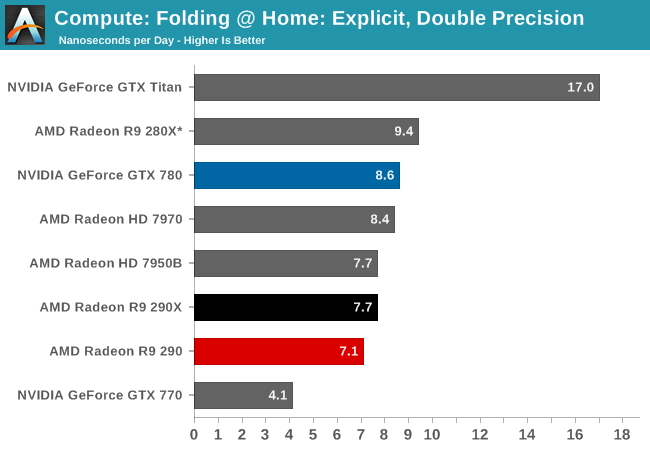
Generally Tahiti and Hawaii are strong performers in the GPU compute arena, but that isn’t of particular help to the 290 here, as it loses out to the GTX 780 in every mode. In single precision FAHBench has trouble putting Hawaii to good use at times, while double precision tests have the 1/8th DP rate 290 and 290X falling behind due to their lower than Tahiti DP throughput.
Wrapping things up, our final compute benchmark is an in-house project developed by our very own Dr. Ian Cutress. SystemCompute is our first C++ AMP benchmark, utilizing Microsoft’s simple C++ extensions to allow the easy use of GPU computing in C++ programs. SystemCompute in turn is a collection of benchmarks for several different fundamental compute algorithms, as described in this previous article, with the final score represented in points. DirectCompute is the compute backend for C++ AMP on Windows, so this forms our other DirectCompute test.
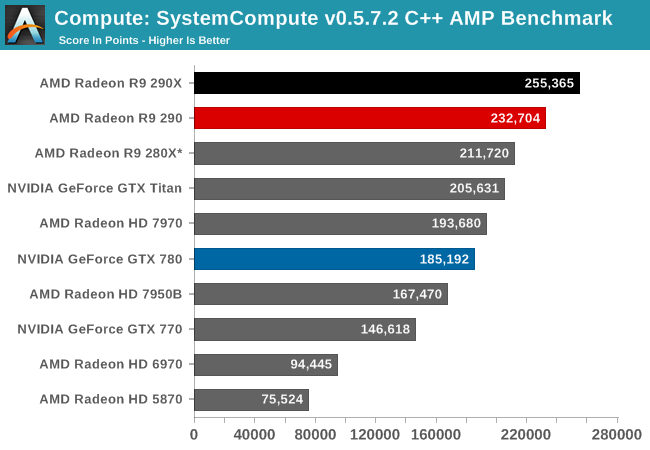
SystemCompute is another benchmark where 290 and 290X do not experience meaningful throttling, and as such are separated by more than what happens in our gaming benchmarks. In this case 290 yet again trails 290X by 9%, though it still enjoys a considerable lead over the GTX 780 and all other NVIDIA cards.










295 Comments
View All Comments
nushydude - Tuesday, November 5, 2013 - link
The gap between the 290 and 290x seems to shrink when you go up the resolution. Does that mean the cards are held back by the memory? If not, what could be the reason for this behavior?Ryan Smith - Tuesday, November 5, 2013 - link
At those resolutions they're more likely to be held back by ROP throughput. Keep in mind that both cards have 64 ROPs, and that the 290 is on average clocked higher than the 290X. So the 290 actually has at least marginally greater ROP throughput than 290X.nushydude - Tuesday, November 5, 2013 - link
I cannot imagine how fast the 290 and 290x would be with proper cooling.TheJian - Tuesday, November 5, 2013 - link
About as fast as the many overclocks around the web show. :) Not much faster than that. If by proper you just mean a better fan/heatsink set up. I don't call water proper. If that's what it takes to run "proper" you need to redesign your chip.With 780 vs. 290x overclocked to max they could get 780 won every benchmark:
https://www.youtube.com/watch?v=djvZaHHU4I8
Both ref designs, benchmarks at 8:40 or so, so proper cooling won't change much I don't think. You will just get less noise or heat, they already run max at 1075 OC'ed as they show here in the 290 review even. You might end up tied or something with 780 (assuming an OC'ed card with better fan gets 5-10% better) but it's not going to blow your mind and a NON ref fan would get more on 780 over what linustechtips vid shows also.
"Similarly we didn’t encounter any throttling issues with our overclocked settings, with every game (including CoH2) running at 1075MHz sustained."
Above from the OC page in this review. It was never throttled and nobody on the web hit higher than 1125 in a review so you're not going to get much more than anandtech did without maybe water or something.
Guru3D OC: 1075/6000
Hardwarecanucks OC: 1115/5684
Hardwareheaven OC: 1100/5500
PCPerspective OC: 1100/5000
TweakTown OC: 1065/5252
TechpowerUp OC: 1125/6300
Techspot OC: 1090/6400
Bit-tech OC: 1120/5600
I can't remember if they mention how high they got the clock in the linustechtips unboxing video above but you can assume they landed somewhere in the group above.
ddriver - Tuesday, November 5, 2013 - link
Amazing performance and value from AMD. This seems just like the GPU for me, since my PC sits in the "server" closet and cables are routed through the wall to my room. Also, amazing compute performance, which is mostly what I need, I might be getting this to replace my aging 470.cartmanasan - Tuesday, November 5, 2013 - link
"To get right to the point then, this [Windforce, DCU2 et.al] is one of a handful of cards we will wholeheartedly recommend. The performance for the price is stunning, ..." - Ryanshodanshok - Tuesday, November 5, 2013 - link
Hi Ryan,the review is generally very well done, and I 100% agree with you the at 150$ price difference, the 290 is basically eating into 290X terrirory.
However, the 290X is clearly an super-enthusiast product, headed to an audience that rarely will not overclock the card (replacing its cooler, maybe with a water block). For this audience, loud/power are rarely of any real concern. So we should consider that, while 290 is very near to 290X, the latter has its "uber mode" to be used. Moreover, as the 290X has a lower voltage, and so an higher efficiency, raising the fan speed even above the 47% threshold should give higher performance boost in respect to the 290. HardOCP did a test with a 290X and a >60% fan speed, and performance was quite higher the "normal" uber mode.
Moreover, while I agree that "loud limit" is a personal affair (and my limit is quite low!), it seems that AMD cooler has a not-so-disturbing pitch. To quote another review:
"Subjectively speaking, there are much more annoying coolers in this territory on the decibel meter. The impressively smooth, gradual ramp of fan speeds up and down in the new PowerTune algorithm helps make the noise less noticeable, too. This ain't an FX-5800 Ultra, folks."
Had you the possibility to hear, side-by-side, the new 290 against, say, a 5870? What was more disturbing? It will be fantastic if you can post a wav/mp3 file recorder at normal distance and closed case...
Anyway, as my "GPU performance ego days" are very far away, I think that Nvidia solution retain some strong appeal to silence-lover.
Thank you and regards.
Ryan Smith - Tuesday, November 5, 2013 - link
"Had you the possibility to hear, side-by-side, the new 290 against, say, a 5870? What was more disturbing?"We've benchmarked both of those cards of course. The 290 is without a doubt subjectively louder, which the hard data backs up.
Per Hansson - Tuesday, November 5, 2013 - link
Some constructive critisism: You can't measure the power of the whole computer and then run a full page on how the 290 draws more power than the 290X.That can be down to any number of things, like the CPU load being higher because of the different VGA load or the computer just deciding to do something in the background, which the later Windows releases loves to.
Techpowerup isolates the card when measuring power, their numbers are here: http://www.techpowerup.com/reviews/AMD/R9_290/24.h...
Load GPU voltage for the 290X measured at a coil is 1.14v, for the 290 it is 1.17v, so very similar to your card but entirely different power consumption numbers.
faster - Tuesday, November 5, 2013 - link
This review makes me appreciate what a value the 280X is. At $300 it performs admirably in games at 1920 x 1080 where the majority of gamers reside. It has much lower noise than the 290 (46 - 50 under load) and temperatures less than the GTX 770 under load. $100 price differential between the 280x and the 290 is not insubstantial to a budget gamer. The 33% increase in price from the 280x to the 290 is rewarded with a 20% increase in performance (approximately). The 280X is the sweet spot for a budget gamer.AMD's competition with Nvidia is an awesome thing for the consumer. Too bad they can't challenge Intel more. I would like to see Intel cut their extreme edition chips down from $1000 because AMD released a killer alternative.